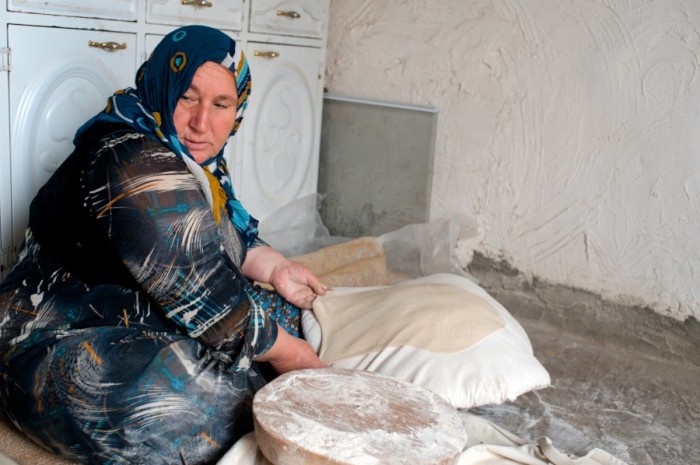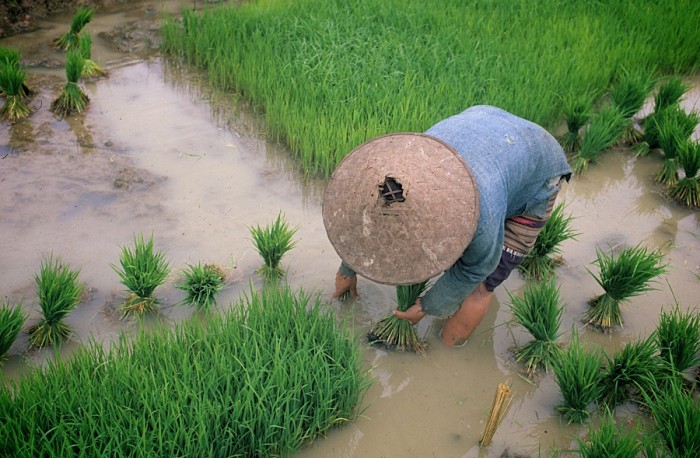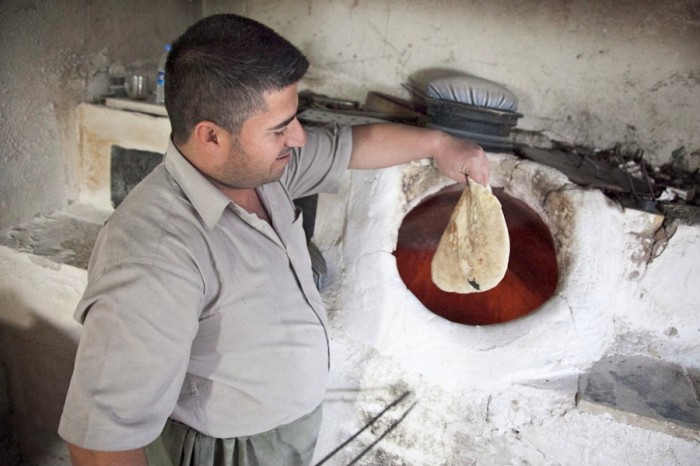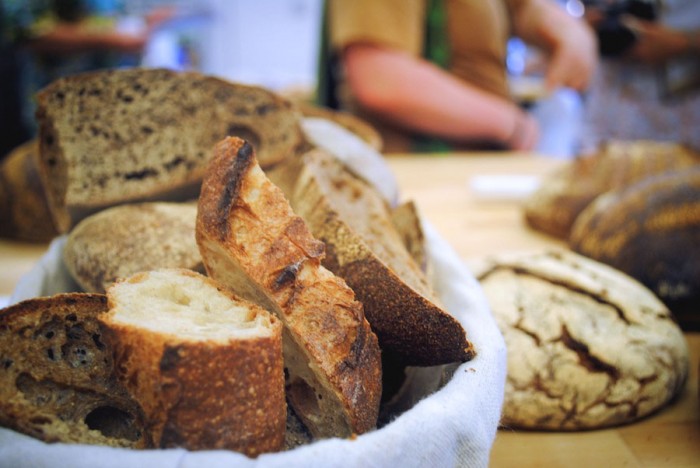
Last week, the annual Grain Gathering (Formerly The Kneading Conference West) brought together hundreds of wheat farmers, home bakers, world-renowned chefs, food writers, plant breeders, and bread enthusiasts from across the Pacific Northwest at Washington State University ‘s Agricultural Research Center in Mount Vernon.
Participants practiced dough-mixing techniques, tested whole-grain pastry recipes, did science experiments at The Bread Lab, and made bad bread puns (“I’m at my wheat’s end here!”)
And they ate gluten. Lots of gluten.
Described as ‘summer camp for bread lovers’, the event centers on the creation of local and regional grain networks in an era where 85-90% of Washington’s wheat crop is exported overseas. Center Director Dr. Stephen Jones has spearheaded a movement to develop an array of Washington-grown wheat varietals (purple wheat, anyone?) bred for nutrition, flavor, and environmental sustainability, that’s garnering national attention.
At first glance, Naomi Duguid, a Toronto-based food writer most known for her impressive survey of Burmese cuisine and international food writing might have seemed a little out of place at the Grain Gathering.
She was there to remind the local food movement of the global roots of its daily bread — from a rice paddies in Thailand to a tandoor ovens in Kurdistan.
Duguid brought the audience of mostly Pacific Northwesterners attention to the fact that the original bread basket of the world is not Kansas or Washington, but Mesopotamia. She talked of places where restrictive American food trends (fat-free, gluten-free) are unheard of, and bread baking is a ritual that’s withstood regime change, war, global warming, and modernization.

In an otherwise festive atmosphere, Duguid also reminded us of the somber reality that for many, bread is a caloric miracle staving off poverty, and of the ingenuity of communities who have, throughout history, made incredible food with limited resources.
For Americans, the absence of a cohesive food culture makes our tastes especially malleable. Duguid’s approach to food writing aims to do for Americans something like what Julia Child did for French food — find kernels of wisdom from a food tradition, and spread the gospel to the American home cook. Her writing — namely on cuisines from Burma, Thailand, China, the Indian subcontinent (and coming in 2016, a book focusing on Iran and the Caucuses) also reflect a large wave of immigration in recent years to North America from these regions, and the corresponding expansion of the American pallet.
“It’s really the only way to understand food, through its local context,” she said, urging participants to take lessons from local food networks abroad like reducing waste, cooking with whole animal and grain parts, and sitting down to enjoy a meal together —a lost art in the hectic digital age.
In a session titled ‘Waste Not,’ Duguid demonstrated recipes from around the globe using leftover bread that would otherwise be wasted. It was a creative and delicious remedy for the sad fact that the U.S. throws away nearly half of its food.
From Chop Suey to Panda Express to Boom Noodle, the franchising and Americanizing of ethnic cuisines is nothing new. Duguid’s approach is unique in that it focuses on the home cook and veers away from fusion. Her cookbooks are integrated with stories and a thorough, socio-political context of the region so that recipes are inseparable from rich history of the place and its people.
“Everytime I’m eating at home, some grain, I’m breaking bread with someone on the other side of the world” she says. “We’re all grain eaters.” We’re growers, too. In 2011 Washington was the fourth largest wheat grower in the country, and the U.S. was the fifth largest producer in the world.

We may all be grain eaters, but there is more to consider when drawing from other food traditions. Much of Duguid’s work centers on places where making good food relies on the techniques of people facing hardship, and there is privilege associated with delighting in these cuisines from afar. She urges western travelers to Asia and The Middle East searching for adventure to slow down, and be open. Above all, eat everything.
“I don’t travel expecting a place to deliver me a particular thing,” she said.
If we do it right, however, we can eat well with a real understanding of a food’s context, whether or not we’ve traveled to the far reaches of India or Morocco.
In articles and books, the local food movement has celebrated chefs and restaurants like Alice Waters for pushing food forward in North America. Duguid, on the other hand, takes a cue from her travels by focusing on the home cook, a title she prefers to journalist, activist, or chef.
“In the home…the economic and gastronomic interests coincide,” she wrote on her blog earlier this week. “The people who deal with these issues of what gets eaten, what goes on the plate everyday, are the people responsible for feeding a household or community…[they] are the people on the front lines.”
As the conference wrapped up and participants went home to Duvall, Corvallis, New York and Toronto, everyone’s idea of local food had widened, just a little. A few hours away in Whitman County, Western White wheat was being processed to eventually become noodles somewhere in Asia, while a Burmese family in Tukwila harvested vegetables from their community garden plot for dinner.
If the food movement is as truly global as Duguid showed us, let’s hope our stomachs are as big as our eyes.

Want to cut down on food waste? Try this recipe from Naomi Duguid:
DEDAS KHARCHO – OLD BREAD FRITATTA
This traditional recipe from Georgia transforms old bread into succulent eating. Quantities are casual. Cubes of dried bread are tossed in hot oil with onions, then simmered in added water. Once they are tender, whisked egg is stirred in, to make a kind of fritatta.
The recipe was given to me in Tbilisi by a woman of eighty-five, the mother of a friend of a friend. She had worked for years as a chemist, in the Soviet era, then, like so many skilled people of her generation, found herself out of work, and with no pension, after the breakup of the USSR. Her garden is a marvel, and so is her pantry, filled with shelves of gleaming preserves.
It feeds 5 or 6 for breakfast or a casual meal:
Ingredients:
-About 3 tablespoons sunflower or other vegetable oil -1 large onion, about 1 ½ cups chopped -4 to 5 cups dried bread, cut into approximate 1-inch cubes -Water -1 small tomato, coarsely chopped (optional) -6 large eggs -About 1 teaspoon salt or to taste -About ¼ cup chopped tarragon or coriander leaves or other —-chopped tender herbs such as sorrel (optional) -Black pepper (optional)To do:
-Heat oil in a wide deep skillet or wide heavy pot. -Toss in the onion, set heat to medium, and cook until translucent, 4 to 5 minutes. -Add the bread cubes and turn and stir to expose them all to the hot oil, a minute or two, then add about 1 cup water and bring to a boil. -Cook for a minute or so, as the bread starts to soften, then add water to cover, bring to a boil, lower heat to medium-low, and cook uncovered until the bread is well softened (3 to 5 minutes, depending on the hardness of the bread). -If using tomatoes, add them a couple of minutes after the water comes to the boil. -Break the eggs into a bowl, add salt and whisk well, then add chopped herbs and black pepper if using, and stir. -Add to the softened bread mixture and stir a little to mix the eggs in. Continue to cook on medium low for about a minute or until the eggs set. -Turn out onto a platter or into a wide shallow bowl and serve.Serve with a salad, or sliced tomatoes and cucumbers, or pickled red peppers. The texture is creamy with tender lumps of bread and rich flavor.

